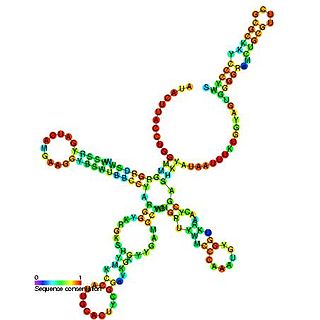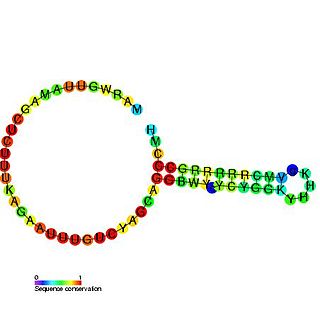Related Research Articles

In cell biology, the nucleus is a membrane-enclosed organelle found in eukaryotic cells. Eukaryotes usually have a single nucleus, but a few cell types, such as mammalian red blood cells, have no nuclei, and a few others including osteoclasts have many.

Cajal bodies (CBs) also coiled bodies, are spherical sub-organelles of 0.3–1.0 µm in diameter found in the nucleus of proliferative cells like embryonic cells and tumor cells, or metabolically active cells like neurons. In contrast to cytoplasmic organelles, CBs lack any phospholipid membrane which would separate their content, largely consisting of proteins and RNA, from the surrounding nucleoplasm. They were first reported by Santiago Ramón y Cajal in 1903, who called them nucleolar accessory bodies due to their association with the nucleoli in neuronal cells. They were rediscovered with the use of the electron microscope (EM) and named coiled bodies, according to their appearance as coiled threads on EM images, and later renamed after their discoverer. Research on CBs was accelerated after discovery and cloning of the marker protein p80/Coilin. CBs have been implicated in RNA-related metabolic processes such as the biogenesis, maturation and recycling of snRNPs, histone mRNA processing and telomere maintenance. CBs assemble RNA which is used by telomerase to add nucleotides to the ends of telomeres.

Coilin is a protein that in humans is encoded by the COIL gene. Coilin got its name from the coiled shape of the CB in which it is found. It was first identified using human autoimmune serum.

U1 spliceosomal RNA is the small nuclear RNA (snRNA) component of U1 snRNP, an RNA-protein complex that combines with other snRNPs, unmodified pre-mRNA, and various other proteins to assemble a spliceosome, a large RNA-protein molecular complex upon which splicing of pre-mRNA occurs. Splicing, or the removal of introns, is a major aspect of post-transcriptional modification, and takes place only in the nucleus of eukaryotes.

The U7 small nuclear RNA is an RNA molecule and a component of the small nuclear ribonucleoprotein complex. The U7 snRNA is required for histone pre-mRNA processing.

Survival of motor neuron or survival motor neuron (SMN) is a protein that in humans is encoded by the SMN1 and SMN2 genes.

Cyclin D1 is a protein that in humans is encoded by the CCND1 gene.

Small Cajal body-specific RNAs (scaRNAs) are a class of small nucleolar RNAs (snoRNAs) that specifically localise to the Cajal body, a nuclear organelle involved in the biogenesis of small nuclear ribonucleoproteins. ScaRNAs guide the modification of RNA polymerase II transcribed spliceosomal RNAs U1, U2, U4, U5 and U12.

Small Nucleolar RNA SNORD88 is a non-coding RNA (ncRNA) molecule which functions in the biogenesis (modification) of other small nuclear RNAs (snRNAs). This type of modifying RNA is located in the nucleolus of the eukaryotic cell which is a major site of snRNA biogenesis. It is known as a small nucleolar RNA (snoRNA) and also often referred to as a guide RNA.

Nuclear factor NF-kappa-B p100 subunit is a protein that in humans is encoded by the NFKB2 gene.

Promyelocytic leukemia protein (PML) is the protein product of the PML gene. PML protein is a tumor suppressor protein required for the assembly of a number of nuclear structures, called PML-nuclear bodies, which form amongst the chromatin of the cell nucleus. These nuclear bodies are present in mammalian nuclei, at about 1 to 30 per cell nucleus. PML-NBs are known to have a number of regulatory cellular functions, including involvement in programmed cell death, genome stability, antiviral effects and controlling cell division. PML mutation or loss, and the subsequent dysregulation of these processes, has been implicated in a variety of cancers.

snRNP70 also known as U1 small nuclear ribonucleoprotein 70 kDa is a protein that in humans is encoded by the SNRNP70 gene. snRNP70 is a small nuclear ribonucleoprotein that associates with U1 spliceosomal RNA, forming the U1snRNP a core component of the spliceosome. The U1-70K protein and other components of the spliceosome complex form detergent-insoluble aggregates in both sporadic and familial human cases of Alzheimer's Disease. U1-70K co-localizes with Tau in neurofibrillary tangles in Alzheimer's Disease.

Small nuclear ribonucleoprotein Sm D1 is a protein that in humans is encoded by the SNRPD1 gene.

Heat shock 70 kDa protein 4 is a protein that in humans is encoded by the HSPA4 gene.

Splicing factor, proline- and glutamine-rich is a protein that in humans is encoded by the SFPQ gene.

Interleukin enhancer-binding factor 2 is a protein that in humans is encoded by the ILF2 gene.

Heterogeneous nuclear ribonucleoprotein R is a protein that in humans is encoded by the HNRNPR gene.

Serine/arginine-rich splicing factor 1 (SRSF1) also known as alternative splicing factor 1 (ASF1), pre-mRNA-splicing factor SF2 (SF2) or ASF1/SF2 is a protein that in humans is encoded by the SRSF1 gene. ASF/SF2 is an essential sequence specific splicing factor involved in pre-mRNA splicing. SRSF1 is the gene that codes for ASF/SF2 and is found on chromosome 17. The resulting splicing factor is a protein of approximately 33 kDa. ASF/SF2 is necessary for all splicing reactions to occur, and influences splice site selection in a concentration-dependent manner, resulting in alternative splicing. In addition to being involved in the splicing process, ASF/SF2 also mediates post-splicing activities, such as mRNA nuclear export and translation.
The Centre for Gene Regulation and Expression, located within the School of Life Sciences, University of Dundee, pioneers new approaches in the field of gene expression and chromosome biology. Previously part of the Dundee Biocentre and receiving significant Wellcome Trust funding from 1995 onwards, it was awarded Wellcome Trust Centre status in 2008. Professor Tom Owen-Hughes is the Centre’s Director.

David L. Spector is a cell and molecular biologist best recognized for his research on gene expression and nuclear dynamics. He is currently a Professor at Cold Spring Harbor Laboratory (CSHL) and head of the Gene Regulation and Cell Proliferation program of the CSHL Cancer Center. Since 2007, he has served as Director of Research of CSHL.
References
- ↑ Gall, J. G.; Bellini, M; Wu, Z; Murphy, C (1999). "Assembly of the Nuclear Transcription and Processing Machinery: Cajal Bodies (Coiled Bodies) and Transcriptosomes". Molecular Biology of the Cell. 10 (12): 4385–4402. doi:10.1091/mbc.10.12.4385. PMC 25765

- ↑ Lamond, Angus I.; Spector, David L. (2003). "Nuclear speckles: A model for nuclear organelles". Nature Reviews Molecular Cell Biology. 4 (8): 605. doi:10.1038/nrm1172. PMID 12923522. Left-hand column, page 607.
- Angus I. Lamond (2013). Pre-mRNA Processing. Springer Science & Business Media. pp. 164–165. ISBN 3-662-22325-2.
- Wu, Z; Murphy, C; Wu, C. H.; Tsvetkov, A; Gall, J. G. (1993). "Snurposomes and coiled bodies". Cold Spring Harbor symposia on quantitative biology. 58: 747–54. doi:10.1101/sqb.1993.058.01.082. PMID 7956092.

The International Standard Book Number (ISBN) is a numeric commercial book identifier which is intended to be unique. Publishers purchase ISBNs from an affiliate of the International ISBN Agency.

In computing, a Digital Object Identifier orDOI is a persistent identifier or handle used to uniquely identify objects, standardized by the International Organization for Standardization (ISO). An implementation of the Handle System, DOIs are in wide use mainly to identify academic, professional, and government information, such as journal articles, research reports and data sets, and official publications though they also have been used to identify other types of information resources, such as commercial videos.
| This cell biology article is a stub. You can help Wikipedia by expanding it. |